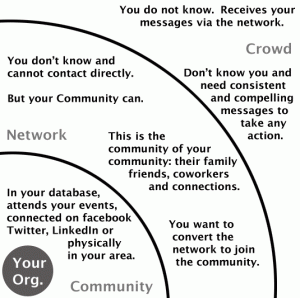Today I am simply going to regurgitate an excellent blog post that I read yesterday by my favourite social media strategist, Amy Sample Ward.
Crowd or community sourcing are definitely worthy tactics in a social media strategy, but they are not for the faint hearted. Engaging with the crowd takes skill and finesse otherwise you will be discarded as a spammer. Amy manages to very succinctly explain the difference between engaging with and using an online community or an online crowd to develop your digital strategy or campaign. I’ve heard of only 2 of my friends or colleagues that have used crowd sourcing – both for creating a logo or design for their business or website and their motivation was usually the low cost and high volume of choice that it offers. From their anecdotal experience my impression was that the quality of the product they received back was also fairly average – however, this could also be representative of the quality of the brief they provided.
The way I interpret Amy’s definition of crowd sourcing versus community sourcing is as follows:
Crowd sourcing is engaging with an online audience that you do not have an existing relationship with to try to mobilise them for your cause, whether it be an advocacy campaign or your business brand strategy. Usually you would engage with “the crowd” via forums or through specific crowd sourcing websites (10 crowd sourcing sites for design, advertising, software, data etc are listed here).
Community sourcing is using your existing network of subscribers, customers, fans and supporters to take action on behalf of your cause of campaign and then share it will their own network of friends, colleagues, fans etc.
Amy provides a helpful infographic that explains the difference and acknowledges that there is definitely some cross over between the two audiences.
 The benefits of engaging with a crowd or community are many; it invites diversity, you can get a very large response in a very short space of time, it stimulates dialogue and word of mouth for your cause, it ensures that your supporters voices are not the only ones heard.
The benefits of engaging with a crowd or community are many; it invites diversity, you can get a very large response in a very short space of time, it stimulates dialogue and word of mouth for your cause, it ensures that your supporters voices are not the only ones heard.
However with every positive there is a negative. When using the community or the crowd, you have to allow time and resource – if the response is good it can be very time consuming to manage the volume of responses. With the diversity you may also find it difficult to find a consistent theme amongst the fragmented opinions that come back – if you already know what you want to do or build, sourcing the crowd may just add an unnecessary element to your strategic process.
And last but not least, Amy gives 3 key tips to consider whenever thinking about engaging with a crowd or online community:
1. Consider your timeframe. Do you just want a quick response or does your campaign require ongoing maintenance with your crowd or community?
2. Give the crowd or community something to do, an action. The crowd will respond best to passive actions (such as signing an online petition) whereas your community has already engaged in this and want something more substantial to do – like calling talkback radio or writing a letter to the editor or speaking with the manager of your local department store.
3. Who is your audience? How many people do you need to reach. Consider if the crowd or community is the right place.
Amy goes on to describe how to design a campaign for a community and how to design a campaign for a crowd but if you want more, please, read Amy’s blog. She’s the expert.

Thanks so much for sharing my post! I’m so glad it was valuable and resonated with you.
As far as the crowdsourcing examples you shared from friends/colleagues, I would be curious to hear if they thought they would try again or what they planned to change about their process the next time.
Thanks again!
Hi Amy,
You’re very welcome. I think they both would use the crowd sourcing again, one is an entrepreneur and is always looking for ways to do things creatively and cost effectively. The other was overwhelmed by the response (70 designs submitted) and provided individual feedback to each one. I think she may not be as conscientious next time but would definitely use it. She got a logo she is somewhat happy with in the end. The funny thing was, when she showed it to me, it was almost an upside down version of a tattoo I have on my back. Had she known she could have traced it off me 🙂
Thanks for sharing your expertise with the world, I love the way you think!